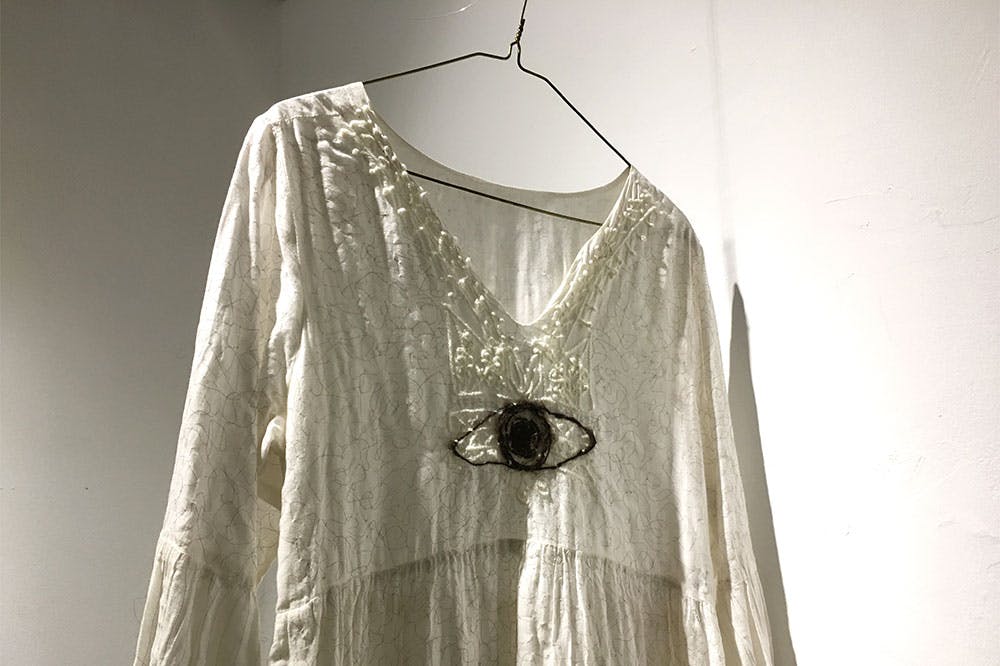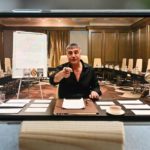Drawings of bare, misshapen bodies cover the inside of a prescription pill box, a worn bed sheet and the torn-out pages of a sociology text. Canvases tinted with tea and stitched with hair hang on a wall across from others painted with a mixture of honey and cigarette ash.
These works are just a few of the 1,500 pieces that the artist Fatos Irwen created from available materials while spending three years in prison. She was convicted in 2017 under Turkey’s broad ‘anti-terrorism’ laws after being caught up in a protest in her home city of Diyarbakir, the unofficial capital of the country’s Kurdish minority population.
‘Kurdish artists have always been living under a very political atmosphere,’ says Irwen, who was released last March. We are speaking in May at the opening of her solo exhibition, ‘Exceptional Times’, that spans two galleries, DEPO and Karsi Sanat, both in Istanbul.
Rights groups such as Human Rights Watch and the artistic freedom organisation Freemuse say the climate has become increasingly oppressive for Kurds and other oppositional voices in Turkey since the mid 2010s, which saw an attempted military coup and the breakdown of a peace process between the government and Kurdish militants.
Irwen and fellow artist Zehra Dogan, who was imprisoned on charges of ‘terrorist propaganda’ on the basis of one of her paintings (a watercolour showing destruction in the border city of Nusaybin), can be seen as symbols of the pressure and censorship Kurdish artists face. Baris Seyitvan, an artist and curator from Diyarbakir, tells me that ‘Artists can’t make work freely without thinking, “If I do this, I might lose my job, I might go to jail.”’
A photograph from Çend Kes (A Few People), part of Rojda Tugrul’s research project GUND (Village)
The pressures are not always so blatant. ‘I found myself doing self-censorship with my dissertation, to the point where it was undermining the research itself,’ says artist Rojda Tugrul, whose work deals with the ecological impact of the conflict and displacement suffered in Turkey’s predominantly Kurdish south-east in the 1990s. Tugrul, who is currently completing a PhD at the Academy of Fine Arts in Vienna, went abroad to finish her studies in part because of the pressure she felt working on this topic in Turkey. ‘I couldn’t express how I felt about the land – I couldn’t use Kurdish names or phrases because I knew the institution would not accept that.’
Another artist, Nejbir Erkol, says the biggest pressure comes from her family. ‘They are afraid for me because of the issues I deal with, but I can’t stand by as if nothing has happened,’ she says. Her ongoing research project ‘Çukur’ (Hole) includes a photo of the hole left by an unexploded mortar that landed near her family home in Nusaybin during a Turkish military operation against Kurdish fighters in northern Syria in 2019.
Falling (2019) from Nejbir Erkol’s project ‘Çukur’. Courtesy the artist
Tugrul says a student exhibition she staged in Mardin, another border city in south-eastern Turkey, was visited by police – a common experience, according to Banu Karaca, an anthropologist and co-founder of Siyah Bant (‘Black Tape’), a Turkish organisation which documents censorship in the arts. ‘It’s not a question of whether artistic production is taking place, but under what conditions,’ Karaca says. She adds that cultural spaces in south-eastern cities like Diyarbakir and Mardin have long been subjected to surveillance, police raids, archive confiscations and requirements for ‘pre-clearance’ by authorities.
Such measures were part of a broader campaign of cultural and political repression, including an outright ban in the 1980s on the Kurdish language itself – the use of which in education, politics and other spheres remains contentious to this day – and the closure of successive Kurdish political parties starting from when they first began to emerge in 1990.
The local elections in Turkey in 1999 brought in a partial respite and a regional cultural flourishing, however, as a Kurdish political party won the mayoralties of Diyarbakir and other south-eastern cities. The new municipalities started opening galleries, theatres and other cultural venues. A handful of Kurdish visual artists like Halil Altindere, Ahmet Ogut and Şener Ozmen became well known, their work on view in museums and biennials both in Turkey and internationally.
‘For our generation, these were very important times. We had our own spaces where we could exhibit and see different artists,’ says Seyitvan, who curated two galleries run by the Diyarbakir municipality. ‘But having all these Kurdish artists, writers and film-makers expressing themselves to the world made the state uncomfortable.’
During the 2000s and early 2010s, ‘there was a demand in the Turkish art scene for Kurdish artists doing political work; it was something almost prestigious to show’, says Mahmut Wenda Koyuncu, who co-curated Irwen’s exhibition. ‘But now they shy away from it; dissident venues like DEPO and Karsi Sanat are among the few who still give space to Kurdish artists doing political work.’
DEPO has paid the price for that support. Its founder, the philanthropist Osman Kavala, has been imprisoned since October 2017, charged with – although not convicted of – involvement in the failed coup and organising previous nationwide anti-government protests. The indictment against him accuses Kavala of ‘carrying out activities that trigger social cleavages’ by using his not-for-profit cultural institution Anadolu Kultur to fund projects related to Kurds and other minority communities. In addition to DEPO, Anadolu Kultur’s projects include the Diyarbakir Arts Centre it established in 2002.
When the central government began replacing elected Kurdish mayors in the south-east with state-appointed trustees following renewed conflict in the region and the 2016 coup attempt, ‘the first places that they closed were the municipal arts and culture spaces’, Seyitvan says. He lost his curatorial job and was also barred from teaching art as part of a broader purge that has seen some 6,000 academics fired from jobs at public universities in Turkey since 2016. After being detained in 2019, he left Turkey with support from Artists at Risk, an international non-profit, and remains abroad. The group says the majority of its residents from Turkey have been of Kurdish background.
‘Many of us had to leave Turkey because we had come to a point where we could not make art,’ Seyitvan says. ‘I am waiting for a change in the politics, an easing of this situation, to go back. I think this is possible, but we have to keep working for it.’
A collective that Seyitvan co-founded, Merkezkac, is one of a group of artist-run initiatives – along with A4, Loading and others – still working to create alternative platforms for artists in Diyarbakir. And a new generation of Kurdish women artists is coming to the fore, often as part of Turkey’s feminist and LGBTQ movements.
Artists in these vibrant but under siege groups ‘share a worry that they will get defined by the repression they face rather than the work that they produce’, cautions Karaca.
Not all Kurdish artists want to address current events in their work, agrees Seyitvan. ‘But when people are living under conditions of conflict, it takes a place in their art,’ he says. ‘Even those who say they don’t want to make political art are making political art.’
‘Fatos Irwen: Exceptional Times’ is at DEPO and Karşı Sanat Çalışmaları, Istanbul, until 27 June.
By: Jennifer Hattam
Source: Apollo



